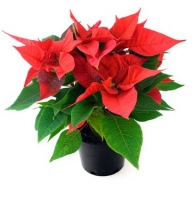![]() Prices in Canadian Dollars.
Prices in Canadian Dollars.![]() Prefer to call and speak to a floral agent? 1-877-277-4787
Prefer to call and speak to a floral agent? 1-877-277-4787
Poinsettias
Poinsettias
Next to the Christmas tree, poinsettias are one of the most popular plants over the Christmas season, recognizable by virtually everyone and a tradition for many. In fact in The U.S the poinsettia outsells all other potted plants combined and December 12th is National Poinsettia Day! Every December this plant can be seen in homes, businesses, churches, and virtually anywhere the holiday is celebrated. Poinsettias are the perfect choice when you want to send Christmas flowers.
Quick Links:
History | Trivia & Fun Facts | Selecting your Poinsettia
Care & Handling | Do’s & Don’ts | Re-blooming for next year
Poinsettias & Health
So, why poinsettias and Christmas?
A brief history…
Poinsettias (Euphorbia pulcherrima) are originally native to an area known as Taxco del Alarcon located in Southern Mexico. The plant was cultivated by the Aztec Aboriginals who referred to it in their language as Cuitlaxochitl (from cuitlatl=residue, and xochitl=flower) meaning “flower that grows in residues or soil. The colourful bracts were used by the Aztecs to make a reddish purple dye and a a fever medicine was derived from the poinsettia’s milky sap (known today as “latex”).
The plant’s association with Christmas appears to have began in 16th century Mexico, where a legend tells of a young girl who was too poor to provide a gift for the celebration of Jesus’ birthday. The story relates that the girl was inspired by an angel to gather weeds and place them in front of the church altar. Bright crimson “blossoms” sprouted from the weeds and became beautiful poinsettias. After the Spanish conquest and the introduction of Christianity, poinsettias began to be used in Christian rituals. During the 17th century, Franciscan friars in Mexico used the plants in their Christmas celebrations. The star-shaped leaf pattern is said to symbolize the Star of Bethlehem, and the red colour represents the blood sacrifice through the crucifixion of Jesus.
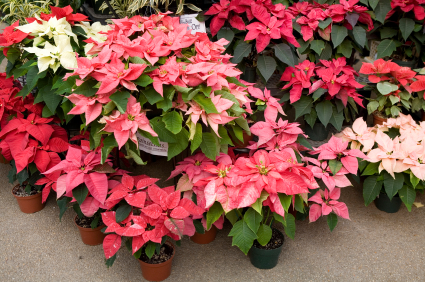 Poinsettias were first introduced into the United States by Joel Robert Poinsett (1799-1851) who served in the South Carolina and U.S. Houses of Representatives and was appointed as the first U.S. Ambassador to Mexico. Poinsett although having attended medical school had a deep passion for the science of botany. Poinsett had plants sent to his home in South Carolina where he maintained hothouses and he began propagating the poinsettia plants. Later he distributed plants to horticultural friends and botanical gardens. Mr. Poinsett is also known for founding the institution which we know today as the Smithsonian.
Poinsettias were first introduced into the United States by Joel Robert Poinsett (1799-1851) who served in the South Carolina and U.S. Houses of Representatives and was appointed as the first U.S. Ambassador to Mexico. Poinsett although having attended medical school had a deep passion for the science of botany. Poinsett had plants sent to his home in South Carolina where he maintained hothouses and he began propagating the poinsettia plants. Later he distributed plants to horticultural friends and botanical gardens. Mr. Poinsett is also known for founding the institution which we know today as the Smithsonian.
The poinsettia has a history with the American public. In the 1830’s, the future Christmas plant’s popularity spread throughout America. The poinsettia’s original scientific name euphorbia pulcherrima, or “very beautiful, ” did not suit the adoring public. “Painted leaf” and “Mexican fire plant” sufficed until the plant was named poinsetta pulcherrima, or “poinsettia”, in honor of Ambassador Poinsett. Congress even deemed December 12 National Poinsettia Day to commemorate the date of Poinsett’s death.
In the 20th century the Ecke family of California has been instrumental in the development of today’s poinsettia which bears an entirely different appearance than those cultivated by the Aztecs or Mr Poinsett. Poinsettias in nature will develop and grow with a somewhat weedy open appearance, the Eckes’ developed a grafting technique to get every seedling to branch, resulting in a bushier plant.
Initially poinsettias lasted only a few days inthe home. All had red bracts. Today’s varieties are more compact, durable, and long-lasting. Red, pink, white, gold, marbled, and variegated varieties are now available. When sending flowers for Christmas, poinsettias can delivered earlier in the festive season than a Christmas flower arrangement and with a little care will last for months.
Poinsettia Trivia and Fun Facts
- The flowers of a poinsettia are the small, cup-like structures called cyathia at the center of the red”petals,” not the red “petals” themselves. These are actually modified leaves called bracts.
- In the United States, December 12 is National Poinsettia Day. This official day has been observed since the mid-1800s. It honors the man and the plant he introduced. Poinsett died Dec.12, 1851.
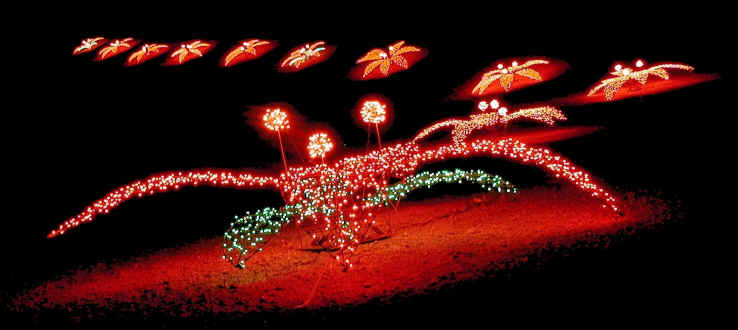 Big Spring, Texas is known as the “lighted poinsettia capital”.When the Comanche Trail Festival of Lights first began the dam at the big spring held four huge poinsettias made of construction rebar welded together in the shape of a poinsettia flower, each was made up of 5 leaves. The leaves were decorated with red Christmas lights. The four poinsettia flowers present anyone entering Big Spring from the south with an incredible sight. In succeeding years additional flowers were added to the dam and inside the park until Comanche Trail Park has a total of eleven lighted flowers on the dam and countless flowers inside the park, making Comanche Trail Park the Christmas Poinsettia capital.
Big Spring, Texas is known as the “lighted poinsettia capital”.When the Comanche Trail Festival of Lights first began the dam at the big spring held four huge poinsettias made of construction rebar welded together in the shape of a poinsettia flower, each was made up of 5 leaves. The leaves were decorated with red Christmas lights. The four poinsettia flowers present anyone entering Big Spring from the south with an incredible sight. In succeeding years additional flowers were added to the dam and inside the park until Comanche Trail Park has a total of eleven lighted flowers on the dam and countless flowers inside the park, making Comanche Trail Park the Christmas Poinsettia capital.- The Ecke family of Encinitas, California, had a virtual monopoly until the 1990’s on commercially grown poinsettias owing to a technological secret that made it difficult for others to compete. However, in the 1990s, a university researcher discovered the method and published it, opening the door for competitors to flourish. Yet even today The Paul Ecke Ranch in California grows over 80 percent of poinsettias in the United States for the wholesale market and approximately 90% of all the flowering poinsettias in the world originated there.
- Would you believe that last year more than 65 million were sold in the United States? Poinsettias accounted for one-third of sales of all flowering potted plants. In economic terms, that’s $237 million out of a total of $781 million in sales of all flowering potted plants! An even more amazing statistic when you consider that the vast percentage of poinsettias are sold within a six (6) week period each year!
- Red is still the most popular color, accounting for roughly three-quarters of all sales nationwide, followed by white and pink. Poinsettias come in a variety of colors from red, salmon, and apricot to yellow, cream, and white. There are also unusual speckled or marbled varieties like “Jingle Bells” and “Candy Cane” with several colors blended together. New varieties are introduced yearly with even more variation in height and colors.
- In the wild, the poinsettia can reach heights of 12 feet with leaves measuring six to eight inches across.
- Poinsettias are generally priced according to the number of blooms. The more blooms, the more expensive the plant.
- Accordingto the University of Illinois, 80% of poinsettias are purchased by women, and 75% of Americans prefer red poinsettias to white.
- There over 110 varieties of poinsettia varieties to choose from.
- In 1992, the poinsettia was included on the list of houseplants most helpful in removing pollutants from indoor air. So it appears they add more than just colour to a home or office at Christmas.
Selecting a Poinsettia
1. Select plants with dense, plentiful foliage all the way to the soil line. An abundance of rich green foliage is asign of a good healthy plant. Avoid waterlogged soil, particularly if the plant appears wilted. Such a condition could be a sign of root rot.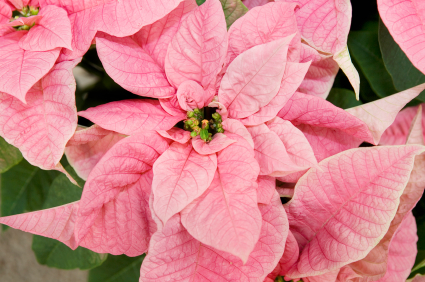
2. Choose plants with fully coloured and expanded bracts. Although many mistakenly think that these bracts are the flower petals, the actual flowers are the tiny yellow clusters found at the centre of the bracts (Bracts are simply leaves masquerading as petals). Avoid plants with too much green around the bract edges, as this is a sign of a plant having been shipped prior to being allowed to sufficiently mature.
3. Avoid plants displayed in paper, plastic or mesh sleeves, or plants that are tightly crowded in a sales display. Poinsettias need space, and the longer a plant remains sleeved, the more the plant quality will suffer. Crowding plants can reduce air flow and cause premature bract loss or other problems.
4. Generally a plant should be 2 1/2 times taller than the diameter of the container it is potted in. This proportion of plant height and shape relative to container size is the key to an aesthetically pleasing poinsettia.
Care and Handling of Poinsettias
1. Avoid Cool Temperatures – When taking your plant home, always ensure to protect it from chilling winds and temperatures below 50° F. Reinserting the poinsettia into a sleeve or a large, roomy shopping bag will usually provide adequate protection for transporting the plant when it is cold and windy. Never leave your poinsettia in an unheated car for any length of time.
2. Watch the water – Root rot from excessive watering is the most common cause of premature poinsettia death. The soil should be allowed to dry completely between waterings.
3. Bright Sunlight – Poinsettias love bright sunlight, so a sunny window is the best place to sit your plant. Be certain though, not to get it too close to the window if you live in a cold climate. Since the glass from the window can be very cold, set the plants away from the glass, or if need be, remove the plant to another location after the sun goes down for the day.
Poinsettia DO’s and DON’Ts
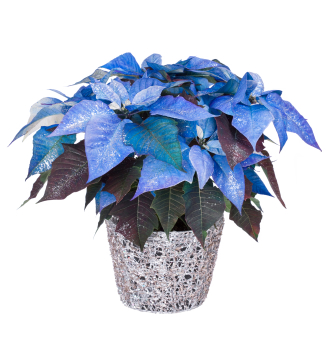
- DO provide your plant with indirect light, they are tropical plants and need plenty of indirect sunlight. If direct sun can’t be avoided, diffuse the light with a shade or sheer curtain.
- DO keep your plant in a warm to moderate temperature of 65 to 75 degrees during the day. Temperatures lowerthan 60 degrees will cause leaves to drop off prematurely.
- DO protect your plant when transporting it.
- DON’T buy plants with limp or curling leaves – these plants have been over-watered and they will invariably disappoint. Avoid soggy plants.
- DON’T over-water! Only water when the soil feels dry to touch. Don’t get any water on the bracts.
- DON’T let leaves touch a cold window as this can also make them drop. Extremetemperature shifts also result in straggly looking plants so avoid drafts.
- DON’T fertilize your plant when it is in bloom.
- DON’T throw your plant out after the Christmas season, with a little TLC it will re-bloom for next year.
Re-blooming a Poinsettia
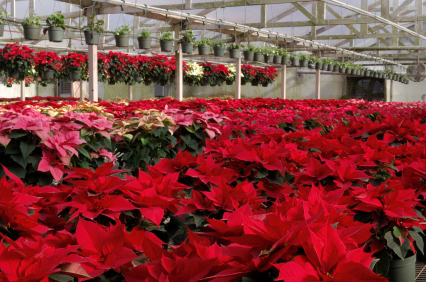 Yes, it can be accomplished, so there is no need to throw out your poinsettia along with your Christmas tree. Tomake your plant flower next Christmas you need to trick Mother Nature. Poinsettias only colour up when the days are short. In order for poinsettias to flower out, they need 12 hours of total darkness each day from the beginning of October onward. Without a cycle of 12 to 14 hours of darkness followed by 10 to 12 hours of bright light each day, a poinsettia will not bloom.
Yes, it can be accomplished, so there is no need to throw out your poinsettia along with your Christmas tree. Tomake your plant flower next Christmas you need to trick Mother Nature. Poinsettias only colour up when the days are short. In order for poinsettias to flower out, they need 12 hours of total darkness each day from the beginning of October onward. Without a cycle of 12 to 14 hours of darkness followed by 10 to 12 hours of bright light each day, a poinsettia will not bloom.
1. Continue to water your poinsettia, keeping the soil moist, but not wet, at all times. Don’t over-water! Keep the plant away from drafts caused by opening doors or heater vents.
2. Transplant the poinsettia into a larger pot containing fast-draining potting soil rich in organic matter.
3. Prune the poinsettia back to about 8 inches in height in late March or early April. By the end of May you should see vigorous new growth.
4. Prune again over the summer to keep the plant bushy and compact. Do not prune after September 1.
5. Place the plant in indirect light or filtered sun and fertilize every 2 to 3 weeks with a complete fertilizer.
6 Starting in October move the plant into a closet each night for 14 hours, making sure it receives no light at all. Each morning move it into the light for a maximum of 10 hours. Remember, the goal is to trick Mother Nature and poinsettias bloom only when they experience long nights.
7. Stick to this schedule every day for 10 weeks and you can will have poinsettia blossoms in time for Christmas.
Poinsettias and Health
 1. Poinsettias ARE NOT Poisonous! – The common and widespread belief that poinsettias are poisonousis a misconception. Ample scientific evidence demonstrating the poinsettia’s safety is well researched and documented. As with any decorative plant, poinsettias are not intended for human or animal consumption, and certain individuals may experience an allergic reaction to poinsettias (see below). However a study by the Academic Faculty of Entomology at Ohio State University using laboratory rats to measure the effects of ingesting large amounts of the plant was unable to reach a toxic level. a diet of poinsettia leaves had no adverse effects, a zero mortality rate, and no symptoms of toxicity, They were fed all parts of the poinsettia to find out if any part of it was even mildly toxic. Apparently, from the rats point of view the poinsettias were completely edible raw, although for a human or household pet to eat them is unlikely as the bitter taste would likely cause them to spit any material out immediately. The study determined that if a 50 pound dog or child could eat the equivalent of between 500 & 600 of the bracts, or drink a pound & a half of the sap, they would still not have reached a toxic dosage.
1. Poinsettias ARE NOT Poisonous! – The common and widespread belief that poinsettias are poisonousis a misconception. Ample scientific evidence demonstrating the poinsettia’s safety is well researched and documented. As with any decorative plant, poinsettias are not intended for human or animal consumption, and certain individuals may experience an allergic reaction to poinsettias (see below). However a study by the Academic Faculty of Entomology at Ohio State University using laboratory rats to measure the effects of ingesting large amounts of the plant was unable to reach a toxic level. a diet of poinsettia leaves had no adverse effects, a zero mortality rate, and no symptoms of toxicity, They were fed all parts of the poinsettia to find out if any part of it was even mildly toxic. Apparently, from the rats point of view the poinsettias were completely edible raw, although for a human or household pet to eat them is unlikely as the bitter taste would likely cause them to spit any material out immediately. The study determined that if a 50 pound dog or child could eat the equivalent of between 500 & 600 of the bracts, or drink a pound & a half of the sap, they would still not have reached a toxic dosage.
So why do so many individuals believe that that the poinsettia is poisonous?
It appears that this myth of poinsettia toxicity began in Hawaii in 1919, when a two year old child was found dead under a full grown poinsettia tree, with a poinsettia leaf in her hand. This is the only death-by-poinsettia ever reported, & it was a completely false report. The urban legend causes untold headaches for florists & poinsettia growers, as nothing seems to be able to put this mistaken belief to rest. Learn More
The bottom line is that Poinsettias are entirely safe and they make a wonderful Christmas gift.
 2. Latex Allergies – Poinsettias belong to the Euphorbia family and the sap from the whole family can cause an allergic reaction in about 2/3’s of the latex sensitive population. In fact, the poinsettia is part of the same plant family as natural rubber latex, which is obtained from the Brazilian rubber tree. In reality the caustic potential of poinsettia latex is about the same as for that of a dandelion. So in general, there is no need to banish the poinsettia from your home or office for fear of allergic reactions.| Christmas Flowers | Christmas Gifts | Flower Delivery for Christmas |
2. Latex Allergies – Poinsettias belong to the Euphorbia family and the sap from the whole family can cause an allergic reaction in about 2/3’s of the latex sensitive population. In fact, the poinsettia is part of the same plant family as natural rubber latex, which is obtained from the Brazilian rubber tree. In reality the caustic potential of poinsettia latex is about the same as for that of a dandelion. So in general, there is no need to banish the poinsettia from your home or office for fear of allergic reactions.| Christmas Flowers | Christmas Gifts | Flower Delivery for Christmas |
| Poinsettias Delivered | Poinsettia Delivery | Facts, Lore, Legends | Poinsettia Toxicity |
Poinsettias and Children | Poinsettias and Pets | Care and Handling | Re-blooming a Poinsettia |


